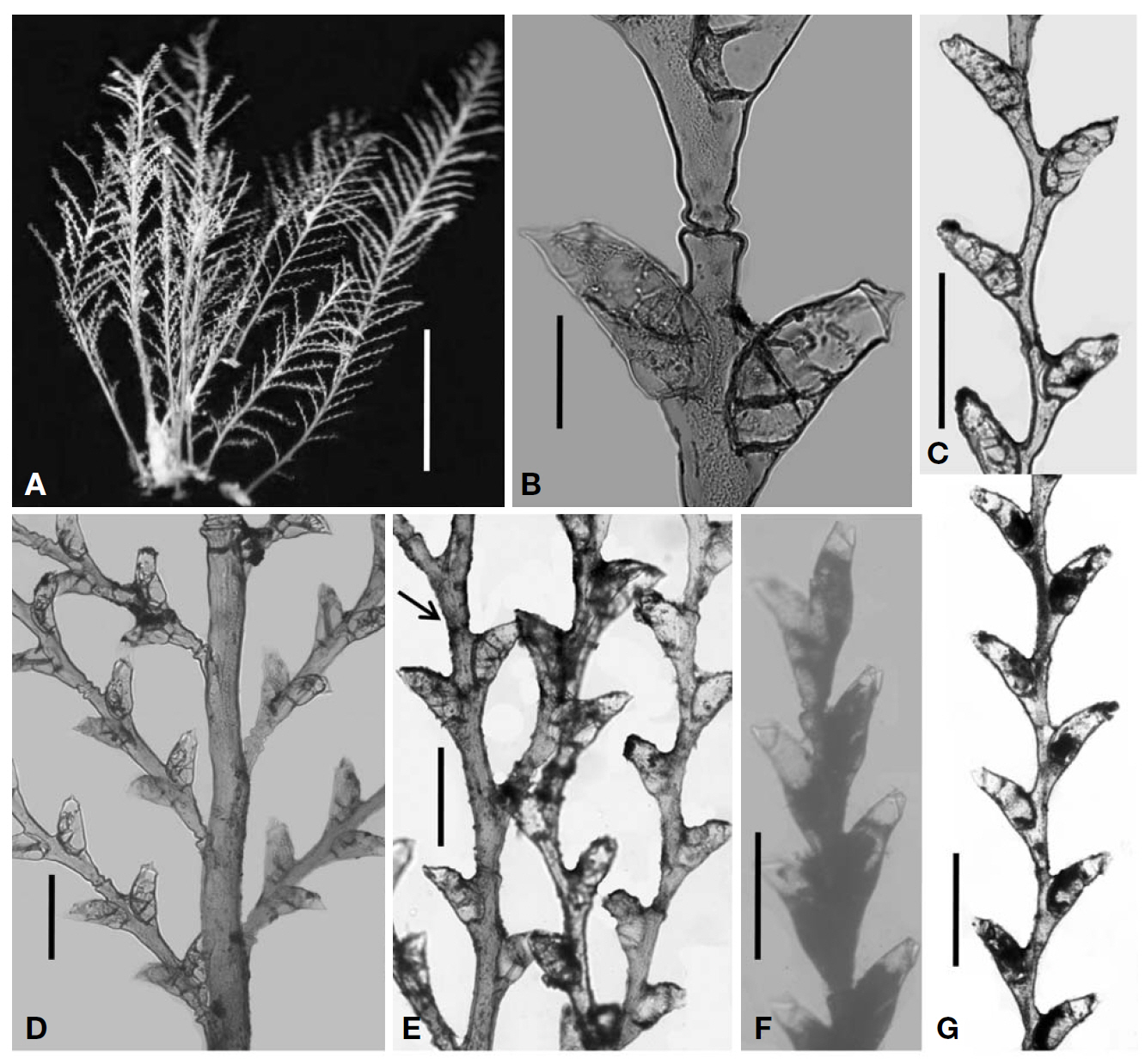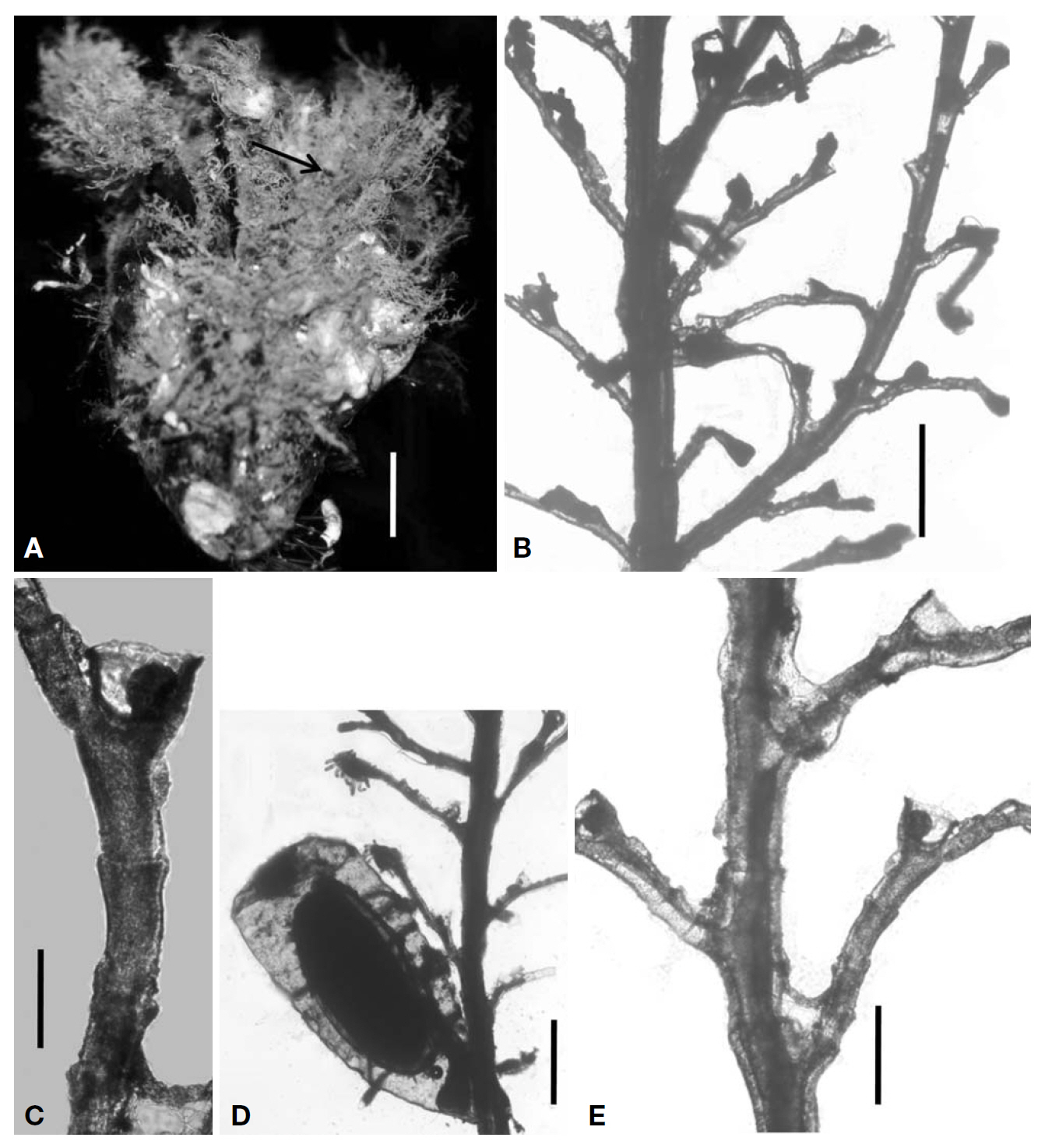



The sertularian and plumularian hydroids are the largest taxa of the hydroid fauna found in the world’s oceans. Currently, 49 sertulariid (32%) and 36 plumulariid (24%) species have been recorded in Korean waters by the author and others. These species have no medusa stage, and their planula larvae are delivered from mature polyps for dispersal. The diverse structures of gonothecae, which protect gonophores, develop from their polyps (Brusca and Brusca, 2003).
Materials were collected from the coasts of Isl. Jeongjokdo (Taean) and Gampo Harbour, Korea, by Mr. B.S. Min on 10 May and 19 October 2010, and were deposited at the Department of Life Science of the University of Suwon, Hwaseong, Korea. Permanent specimens were prepared for light microscopy examination. Photographs of individual specimens and colonies were taken using a microscope (E-80i; Nikon, Tokyo, Japan) and a digital camera (EOS 300D; Canon, Tokyo, Japan).
Phylum Cnidaria Hatschek, 1888
Class Hydrozoa Huxley, 1856
Order Thecatae Fleming, 1828
Family Sertulariidae Hincks, 1868
1*
Korea: Chungcheongnam-do, Taeangun, Isl. Jeongjokdo, 28 May 2010, Min BS, attached on rock in coast.
Colonies erect, pinnate, up to about 50 mm long. Two types of colonies present: one straight, without hydrothecae on stem; others sinuous with hydrothecae on stem. In some other types of colonies, lower portion of stem without hydrothecae and straight and upper portion of stem with hydrothecae sinuous. Some of branches redivided into dichotomously. Hydrothecae arranged in subopposite or in alternate, tubular, tapering distally, widest in center, abcauline wall slightly concave, with two round marginal teeth equal or outer longer, operculum with two flaps. Gonothecae not observed.
Arrangement and inclinations of hydrothecae are variable. In the lower portion of the branches, hydrothecae show an alternate arrangement; however, in the upper portion, hydrothecae show a subopposite arrangement. Hydrothecae incline outward at a 30-60° angle, and the adcauline wall is adnated about one-third to one-half on the lower portion, with the remainder freely protruding outward.
Korea, Japan, North Pacific, North Atlantic, and Arctic Oceans.
Family Plumulariidae L. Agassiz, 1862
1*
Korea: Gyeongsangbuk-do, Gampo Harbor, 19 Oct 2010, Min BS, attached on the shell of bivalves (
Colonies small, less than 30 mm high, branched irregularly. Stem polysiphonic throughout, but gradually becomes monosiphonic upward. Branches monosiphonic or polysiphonic and divided into regular internodes; each internode has one hydrocladium arranged in alternate. Hydrocladia arise from stem and branch, which arranged in opposite or in alternate. Hydrocladia divided into thecate internodes with hydrotheca and athecate internodes without hydrotheca. Thecate internode long, with one hydrotheca at one-third its
upper side, one inferior nematotheca, one upper mesial nematotheca. Hydrotheca shallow, present on upper side, and directed obliquely upward; adcauline wall largely adhering and has a short free part. Nematotheca nonthalamical and immovable. Gonotheca large compared with hydrotheca, arise from basal portion of stem or stolon, cylindrical, and taper gradually below with many transverse rings over almost its surface; pedicel short, slender and located above truncate with orifice.
This species is similar to
Korea, Japan, Britain, and Venezuela.
Korean name: 1*고운화관히드라 (신칭) Korean name: 1*무늬깃히드라 (신칭)

